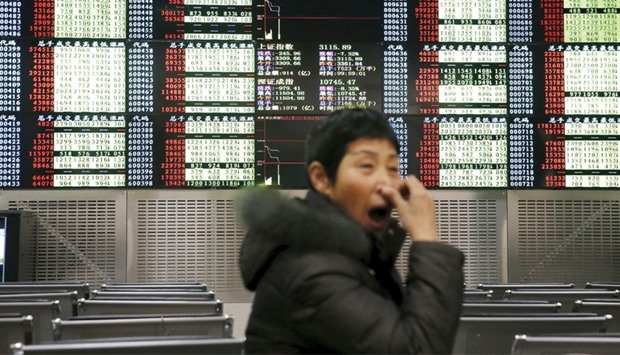A new circuit breaker designed to stem volatility in China’s stock markets by halting trade when the market plunges, was making it worse, investors and analysts said yesterday after the mechanism brought trade to an end for the second time this week.
Investors say the circuit breaker on the Shanghai and Shenzhen stock exchanges, which suspends trade for 15 minutes when the market falls 5% then halts it for the day after a fall of 7%, changes the way investors trade in a way that fires up selling pressure rather than cooling it. They say the trigger levels for the breaker, introduced on January 4, were too low and too close together to work effectively.
“The 5% threshold is clearly too low for a market as volatile as China’s,” said Tom Rafferty, Asia Economist at The Economist Intelligence Unit.
“Once the 5% threshold is hit, investors inevitably pile in with sell orders. I would expect an upper adjustment in the threshold level as well as other changes to be introduced soon.”
And with just a 2 percentage point gap before the permanent halt, investors fear that “if they don’t sell early they won’t be able to, because the circuit breaker will kick in”, said Shane Oliver, head of investment strategy at AMP Capital in Sydney.
Nomura’s China analyst Wendy Liu said in a Jan. 5 note that circuit breakers had worked well in many countries, including the US, Korea and Japan, but agreed China’s trigger thresholds were too close together, adding to investors’ fears.
“As a comparison, the US has set three thresholds of 7%, 13% and 20%, and Korea has set three thresholds of 8%, 15% and 20%,” she wrote.
The S&P 500, whose circuit breaker is the benchmark on which many other bourses have modelled theirs, is much less restrictive than China’s and also factors in what time of day selling occurs. Before 3:25 pm, trade is halted for 15 minutes if the index falls 7%, then for another 15 minutes if it falls 13%, and finally stops trading altogether when the market tumbles 20%. If it is after 3.25 pm, only a 20% drop will halt trade. India, like China an emerging market that closely controls its capital account, adopts a similar approach but with threshold falls of 10 and 15% for trading halts and 20% for shutdown, with longer trading halts imposed as the day progresses.
Bernard Aw, market strategist at IG in Singapore said China might be better served by something more like Singapore’s approach.
“Singapore has a dynamic limit, where the 10% upwards or downwards band is based on the last traded price at least 5 minutes ago, instead of the previous closing price or the start of the trading day. It could be more effective in terms of injecting some calm into the market because traders know they can get out, even if they can only trade within that percentage. It doesn’t induce the fear that you can’t get out.”
The new circuit breaker is the latest in a series of measures introduced by Beijing in the hope of avoiding a repeat of last summer’s market crash, which wiped out a third of the value of local bourses within a month.

An investor yawns in front of an electronic board showing stock information, after the new circuit breaker mechanism suspended yesterday’s stocks trading in Shanghai.


